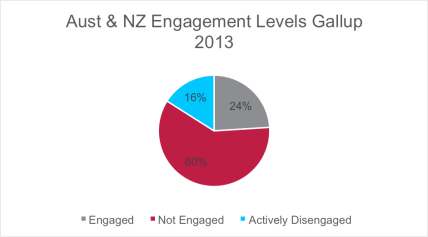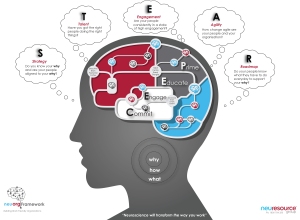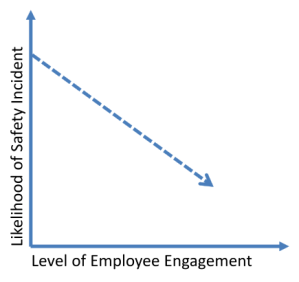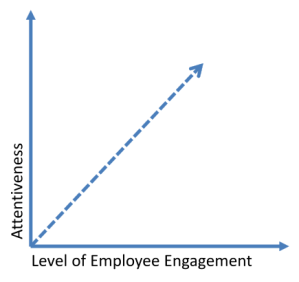How does your engagement measurement stack up?
In this post, Linda Ray, co-founder and co-director of neuresource group, shares our tools for building a high performing organisation with a sustainably engaged workforce.
According to Gallup’s 142 country study on the State of the Global workforce only 13% of employees worldwide are engaged at work http://www.gallup.com/poll/165269/worldwide-employees-engaged-work.aspx
Whilst Australia and New Zealand are above the world average at 24% measured as engaged, there is clearly room to improve given 60% are identified as not engaged and 16% as actively disengaged.
We know that when people are not engaged they lack motivation and are less likely to invest discretionary effort. Those actively disengaged negatively impact on co-workers through emotion contagion. Many organisations measure engagement via the once per year survey and then spend a couple of months analysing the data. Clearly we need to do something differently. The reality is we used to talk about morale but engagement comes largely from inside of us and is influenced by factors outside of work. Financial stress and increasing pressures to do more with less impact on engagement. We also know that leaders influence the engagement climate as do business practices.
There are recognised keys to operating as a high performing organisation with a sustainably engaged workforce. We did a lot of thinking about this and have been influenced significantly by insights from neuroscience, particularly the ideas that the key organising principle of the brain is to minimise threat and maximise reward and the notion that the brain is a social organ.
In our work with businesses we share Simon Sinek’s Golden Circle model and consistently find that, while organisations can talk about their ‘what’ and ‘how’, rarely have they clearly articulated their ‘why’. Most organisations and businesses mistakenly believe their ‘why’ is captured by their mission statement. When your people buy the business ‘why’ and feel connected to it, they will be more motivated to put in discretionary effort. We do a lot of work with organisations to help them think through and articulate a shared ‘why’. We use a simple model in our work called the STEAR model.
In the STEAR model there are 5 key areas to pay attention to.
The first of these is to understand your strategy. Do you know your ‘why’ – why you do what you do – and are all the people in your organisation aligned to your’ why’? It is the purpose of the business and it is not about what you do but rather why you exist.
The second area is looking at the talent of your people. Have you got the right people doing the right things? We know when you can align people’s natural talents with things they like doing they will be more engaged. Do you have a development strategy for growing the capability of you staff?
Are your people consistently in a high state of engagement? Do they love what they do? Do you have practices that measure engagement regularly?
We are in a time of constant change. Times of change require us to demonstrate agility in order to prosper. How change agile are your people? What is your plan for managing change fatigue?
Finally we all need a clear roadmap. Do your people know what they have to do everyday to support your ‘why’? This links back to your purpose and your strategy. A leader/business owner needs to be mindful of all of these areas.
Focussing attention solely on the engagement, in isolation from the other key components that impact on engagement, is unlikely to change the levels of engagement.
In earlier blogs we have shared our 3 E’s model. We are using our platform Neu360 which supports a business to do quick pulse surveys to check in with their people to determine engagement ‘hotspots’. This is much more effective than the once a year survey and may mean we can intervene in a much more timely manner to address any issues that may be resulting in low morale and low engagement. What are you doing in your business to support engagement? How are you STEARing your organisation and are you paying attention to all of the areas that support a high performing organisation?
Linda is the Managing Director of NeuroCapability and the co-founder/director of neuresource group. These organisations are playing key roles in developing a new generation of thinking leaders through delivery of the Diploma of Neuroscience of Leadership and other innovative programs informed by neuroscience. Linda is gaining recognition both in Australia and internationally as a thought leader in the neuroleadership field. She is actively contributing to the body of knowledge that supports the building of individual and organisational ‘neurocapability’.
Read Full Post | Make a Comment ( None so far )Employee Engagement: Why You Should Care
Motivation expert and an advocate for the use of neuroscience insights in business practices, Bronny Coombes looks at the relationship between employee engagement and safety through a neuroscience lens.
_____________________________________________
Since 1997 Gallup has been exploring the links between workforce engagement and organisational success. In its eighth iteration, the 2012 Gallup research clearly highlights this link and shows some consistent outcomes to its 2009 research findings.
The 2012 Gallup analysis ”examined 49,928 business or work units and included about 1.4 million employees in 192 organizations, across 49 industries, and in 34 countries. Employee engagement affects nine performance outcomes, including approximately 48% fewer safety incidents, 21% higher productivity and 22% higher profitability.”
According to the Australian Bureau of Statistics the most common causes of workplace deaths during 2009-2010 were incidents caused by vehicles; falls from heights; hit by moving objects; hit by falling objects. Released in March 2012, Safe Work Australia estimates the cost of work related injuries to be more than $60 billion dollars for 2008-2009–this represents nearly 5% of GDP!
The following table breaks down the associated costs for work related injuries.
.
.
The connection between engagement and safety
In the 2007 SHRM Research Quarterly, results of research in a manufacturing company showed that their engaged employees were five times less likely to have a safety incident and seven times less likely to have a safety incident involving lost-time.
An engaged person is naturally motivated toward their work – they find their work rewarding. They are the person who is intrinsically driven to perform well; they naturally bring ‘more’ of themselves to the work environment. They are the energised, focused, proactive and absorbed member of a team who provide high quality results. They ask quality questions and are able to problem solve in situations.
According to Dan Pink, author of Drive: The Surprising Truth About What Motivates Us, the factors that create employee engagement are:
- Autonomy: the ability to control aspects of our time, tasks, techniques, and teams
- The opportunity for mastery
- Purpose: a connection to something larger than ourselves
Evian Gordon, 2008, proposes the brain is organised to minimise threat and maximise reward. The neural basis of engagement can be defined by activation levels of the brain’s reward circuitry. Disengagement, on the other hand, is defined by the activation levels of the brain’s threat circuitry. When we engage in work that drives our brain’s reward circuits, the neurotransmitter dopamine is released. Dopamine also positively influences other neural networks. We experience a heightened sense of awareness and attentiveness: we ‘feel’ good, we easily retain focus, we think and rationalise more clearly, we have clarity of purpose, we ‘get lost’ in time, we make better connections for improved decisions, our energy remains high, and we successfully solve problems. And all of this is surprisingly effortless for such a quality outcome.
So, if each of our brains constantly scans the environment for any perceived threats, why is an engaged employee less of a safety risk than a disengaged employee?
Quite simply, engaged employees are more likely to feel safe in their work environment. They are also less likely to have work-related accidents. Some of this is because they are more easily able to identify the safety threats in their environment. Additionally, their perception of such threats is more accurate.
.
Disengaged employees, however, are less likely to feel safe in their work environment. The threat circuits of their brains are on constant alert for a wide array of possible reasons: anxiety from work related issues or conditions, threatening leadership or leadership styles, sadness, despair, anger, fear of failure or poor performance. Disengaged employees are easily distracted, are more difficult to motivate, have lower levels of attention to detail,and find it more difficult to make good decisions or to problem solve independently.
With a perceived threat in the environment, the brain shuts down the ability to work well. Thinking clearly becomes a problem because enormous amounts of brain resources are diverted to protection. Work naturally requires a lot of effort and energy. When the brian’s resources are directed elsewhere, judgement errors occur, something that can easily which affect personal safety. Disengaged employees are more likely to have work related accidents. Because their work environments seem to be fraught with dangers, they are unable to identify the real impending threats.
The connection between engagement and recruitment
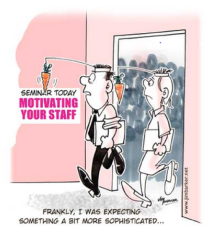 There is another dimension to employee engagement, and that is hiring the right person for the right work. Disengagement is the result of a poor hiring process and comes at an enormous cost to an organisation.
There is another dimension to employee engagement, and that is hiring the right person for the right work. Disengagement is the result of a poor hiring process and comes at an enormous cost to an organisation.
As far back as 1997, Iverson & Erwin, and more recently by Nahrgang, Morgeson and Hofmann, research on safety at work suggests that people who are not a good fit for their work environment are at greater risk of injury. It is now possible to use the latest in brain science research to select candidates for positions based on preferences for behavioural and working styles. This allows savvy leaders to cultivate engaged employees from the moment they step into the organisation.
Imagine outlining to a potential candidate what type of work they need to love to do in order to feel successful in their work. Imagine a candidate being employed for what they love to do? And imagine a safer work environment for everyone.
.
.
_____________________________________________
 Having studied Human Movement Studies, Psychology, Sociology and Philosophy, Bronny Coombes is curious by nature. She spent a number of years challenging the relevance of education programmes in a changing world and went in broader search for new learning, ultimately landing in that fascinating world where people, technology and performance meet–work!
Having studied Human Movement Studies, Psychology, Sociology and Philosophy, Bronny Coombes is curious by nature. She spent a number of years challenging the relevance of education programmes in a changing world and went in broader search for new learning, ultimately landing in that fascinating world where people, technology and performance meet–work!
Her work focuses on what drives human performance in organisational culture, how to apply learning to help improve individual and team performance.
She collaborates with a number of high performing people in a variety of Australian organisations, covering all kinds of motivational topics, having plenty of fun and innovating along the way.
.
Read Full Post | Make a Comment ( 1 so far )